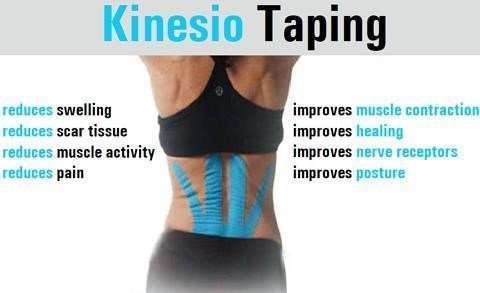
You’ve seen it on TV and said to yourself “What’s the funny different colored tape on everyone?” You’ve seen it around town and on your friend at the gym. Did you know that even though it gained popularity during the last Olympic games, kinesiotape has been around since 1979? Dr. Kenso Kase developed both the method and the first elastic therapeutic tape, Kinesio Tape. He also founded Kinesio, the company behind the product, in the 1980s, and formed the Kinesio Taping Association (KTA) in 1984. But it wasn’t until major Olympic athletes like track stars Trey Hardee and US women’s volleyball stars Kerri Walsh and Jennifer Kessy began donning the tape that the majority of the nation began to notice.
Kinesiotape is designed to mimic the body’s own natural function of the skin by allowing normal range of motion and movement without restrictions. Depending on the goal in mind, kinesiotape can be applied to either help promote movement, inhibit movement, decrease pain and allow improved lymphatic function. Most importantly the tape allows the body to return to homeostasis. To ensure a full range of motion for the wearer, Kinesio Tape is very thin and made with a porous high grade cotton fabric. The fabric lets the skin breathe and has an elasticity comparable to that of the skin and muscles. The sticky side of the tape uses a water-repellent, medical-grade acrylic adhesive that is latex free and that further supports the muscles and connective tissues. In addition, the tape can stay put for three to four days even through sweating and showering making it very versatile.

When applied the tape is designed to perform 4 basic functions;
- Supporting the muscle — Proper taping improves the muscle’s ability to contract even when it’s weakened, reduces a feeling of pain and fatigue, and protects the muscle from cramping, over-extension, and over-contraction which ultimately means less irritation.
- Removing congestion to the flow of body fluids — Kinesio tape improves blood and lymphatic circulation and reduces inflammation and excess chemical buildup in the tissue.
- Relieving pain — by decreasing stress and strain on muscles, tendons, ligaments and tissue, as well as decompression of nerve ending by decompressing the dermis and epidermis layers of the skin.
- Correcting joint problems — The goal is improving range of motion and adjusting misalignments that result from tightened muscles.
Some of the more common ailments that can be treated by kinesiotape are:
- Achilles tendonitis
- Plantar Fasciitis
- Shin splints
- Runners Knee
- Ankle sprains
- Tennis Elbow
- Frozen Shoulder
- ITB syndrome
- Swelling
- Pain
- Lymphodema
- Low back pain
- Neck pain
- And many more…
How it works
The two key points of the kinesiotape method are stretch and direction. Kinesiotape allows for it to have a potential stretch between 130 and 140 percent of its original length and has a certain amount of stretch to it even before you remove the paper backing. The direction applied combined with the stretch will determine the desired outcome. Even though there are other companies that claim to offer the same benefit as kinesiotape and tape is readily available in stores and online, application by a trained professional is important to achieve the desired results.
Other benefits include improved circulation, muscle support, and an improved healing time. Its primary benefit over traditional athletic tape is that it’s designed to allow freedom of movement and flow of body fluids to speed the healing process.
A kinesiology tape application will last three to five days, and most of the patients will notice a change in the treated area within 24 hours. When removing the tape, we sometimes give the area a break for a day or two before applying more tape most people however can tolerate 2-3 applications before rest is needed.

Another important consideration when using kinesiology tape is which brand to choose. Kinesio holds a patent for its manufacturing process, and it owns the trademarks for the Kinesio brand and Kinesio Taping. Competitors have engineered tape with very similar qualities to Kinesio Tape and claim to offer the same function. Kinesio has a significant advantage, though, in that it is the only producer of kinesiology tape to offer training from certified professionals on how to use it properly. We prefer the Kinesio brand because it stays on the longest. The pre-cut tapes are less desirable because we believe it’s important to customize the length of tape for the patient and injury being treated.
Not every treatment option is right for everyone but if you’re interested in seeing if Kinesiotape is right for you, let us show you how it works. Let us help you get back to doing what you love.






